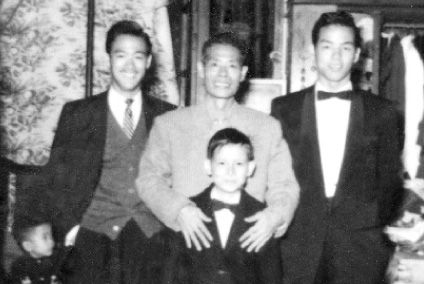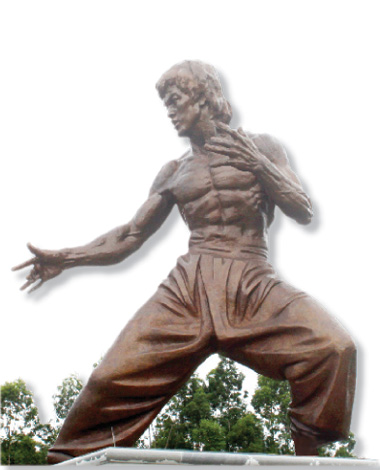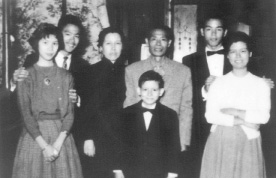The private life of a kung fu icon
Updated: 2010-08-12 07:32
By Ming Yeung(HK Edition)
|
|||||||||
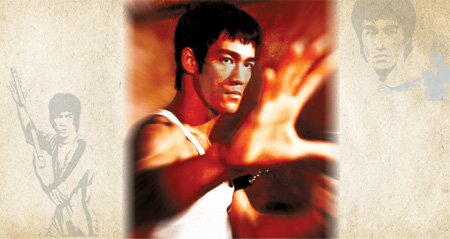
|
Bruce lee club Bruce Lee (left, back row) and his younger brother Robert Lee (center, front row) in a family photo. |
Bruce Lee's stardom has never dimmed, not for millions of his movie fans, not to those he inspired to take up martial arts, nor to his younger brother, Robert. Ming Yeung reports.
It's 37 years since Bruce Lee died, his life mysteriously cut short by a cerebral edema that killed him at the age of 32.
Bruce Lee was an indomitable martial artist, and still is, to die-hard fans all around the world. To Robert Lee, his brother, Bruce Lee was an ideal man, a role model and a deeply beloved family member.
Bruce loved and cared for his family very much, Robert remembers. Once at the dinner table, their mother complained that Bruce seldom talked to her. The actor answered, "Mom, let me tell you a story. One day, if you and I walk into a jungle and there's tiger going to attack you. I will not hesitate to fight with the tiger and let you run away. End of story."
Though Bruce was considered a super star, Robert recalls his brother as a "down to earth" young man who exuded a happy-go-lucky demeanor. Robert related one incident: Bruce was teasing his friend, artist Maggie Li Lin-lin on a movie set one day. Lee pressed a coin to her forehead. Then he asked, "do you feel it sticking to your forehead?" She said yes. "But it won't fall off even if you pat your head," Lee told her. Maggie Li was skeptical. She began shaking her head vigorously, looking as if she were having a seizure. Lee actually had used a sleight of hand technique to remove the coin from her forehead. What transported Li into making a spectacle of herself really was only the impression of the coin.
|
A 12-meter-high bronze statue of Bruce Lee is under construction in the small town of Xiacun in Guangzhou. Provided to China Daily |
Bruce was born in San Francisco but grew up as a tough Hong Kong street kid. He learned basic martial arts from the famed Wing Chun master Yip Man. Lee trained obsessively at martial arts, until he became frustrated with the limitations and formalities of traditional techniques. He evolved his own martial arts style which he called, Jeet Kune Do. The name "Bruce" was added to Lee's traditional Chinese name by a member of the medical staff at the San Francisco hospital where he was born. (His parents later accepted it, thinking it would be helpful.)
Bruce Lee was exceptionally fit and capable of extreme physical feats, including one-handed, two-fingered push-ups and his famous "one-inch" knockout punch.
Lee blasted into the world spotlight in the role of Kato, sidekick of the "Green Hornet" in the television series of the same name.
The show was extremely popular in Hong Kong, where it was referred to as "The Kato Show." Hong Kong kids believed Lee's character was the real star of the show.
One day, at the height of his success, Bruce Lee would sit before a television camera and tell an interviewer, "oftentimes people ask me 'Hey Bruce, are you really that good?' If I tell you I'm good, probably you'll think I'm boasting. If I tell you I'm no good, you know I'm lying."
But on the night before leaving his home and Hong Kong to return to the US the usually ebullient young man was downcast.
He was 19 and bound for the University of Washington to study for a degree in philosophy.
Robert recalls their father as exceptionally strict and hard-to-please. "Our father gave him a 100 dollar note and told him to do his best, that's it," Robert says.
The younger brother remembers that night and how his beloved older brother shared with him his fears and uncertainties as he embarked on a new phase of his life.
"Puppy (Robert's infant name), I'm leaving the family and going to a new place tomorrow ...," Robert remembers him saying. Robert said he felt stunned as he witnessed the vulnerable side of Bruce Lee for the first time.
While Bruce plunged into the stream that would someday make him an international icon, he poured his feelings into words, that he sent home in letters to his family every other day. "He only let us know the bright side of his life without any remorse," Robert reminisces.
Bruce didn't disappoint his father. He supported himself by teaching his fellow students kung fu. Some of his students were non-Chinese, which was considered taboo in those days. In 1963, when Bruce returned to Hong Kong and the family went to greet him at the airport. "I saw him carrying a short jacket, walking towards our father and saying, 'hey dad, it is the 100 dollar note you gave me. And this jacket is just for you.' It was the happiest moment for our father," Robert recounts.
|
Bruce lee club Bruce Lee (left, back row) and his younger brother Robert Lee (center, front row) in a family photo. |
Like father, like son. Bruce was equally strict with Robert, the brother eight years his junior. In 1969, Robert's opportunity came, to join his brother in Los Angeles. Robert arrived, very obviously underweight, Bruce spotted him at the airport, walked over and gave him a bear hug. He teased Robert saying "young man, don't tell anyone you're my brother or you'll embarrass me."
In the morning of the second day after Robert's arrival, Bruce took his brother jogging. Robert didn't know what "jogging" was, but decided to go along. "Bruce suggested I slow down if I could not keep up his pace. He ran home and I was chasing behind him. By the time I arrived home, I ran straight to vomit owing to fatigue," Robert says, rather embarrassed.
Seeing that his brother was not so much into exercises, Bruce changed his strategy. He blended a milkshake-like drink mixing up 3,600 calories protein powder with milk, banana, two eggs, ice-cream and peanut butter for Robert. "You gotta drink this thing every day from now on to complement the three meals," Bruce ordered. And it worked. Within two weeks, Robert gained 16 pounds and tipped the scales at 124 pounds.
Well aware of his brother's inability to learn kung fu, Bruce recommended Robert learn one important technique - to run, as fast as he could. "You have no killing instinct. Run faster so that people can't catch you when you get into trouble with them," he teased him.
Bruce once said, "I have no fear of opponents in front of me and I am very self-sufficient so that they do not bother me ... they'd better kill me before." Nonetheless, His intrepidity didn't come easy. The grueling, or even inhuman, training Bruce Lee undertook enabled him to stand alone at the highest possible level of physical fitness. "The only opponent to Bruce was himself. He had unlimited expectations and challenged himself to see how much he could achieve," Robert comments.
Tough as Bruce was, Robert remembers vividly the only time he saw his brother cry, when their father died in 1965. Bruce was not able to see him before he died, because his wife had just given birth to his son Brandon. Lee's failure to see his father was considered unfilial in the Chinese community back then. "The funeral was held at the Kowloon Funeral Parlour. The moment Bruce stepped out of the lift, he fell towards the memorial hall, crying hard," Robert says.
On July 20 of 1973, Robert received a phone call from a friend that Bruce had died in Hong Kong. Robert thought the call was a mean practical joke. He learned the report was true when he and his mother sat down to watch the news report on television. Bruce's body was returned to Seattle in late July.
What would it be like if Bruce had not died at such a young age? "I believe he would not be happy," Robert says. He remembers back to a day when the two brothers went shopping and Bruce spotted an old man holding a walking stick, Bruce sighed and said, "I don't wanna be like him one day."
Robert believes Bruce made the most of his life. His ideology and impact sustain. His legacy grows stronger. "What's more to ask for?" Robert queries. "He's like fireworks, releasing all his power and glories in a short period of time but the images will remain on people's minds forever."
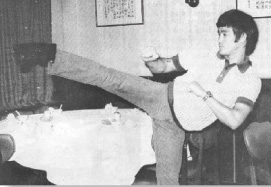
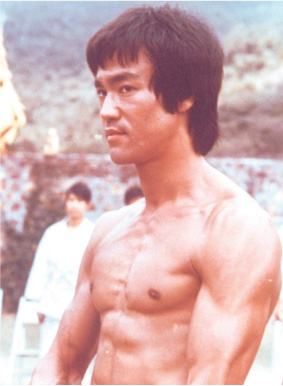
(HK Edition 08/12/2010 page2)
